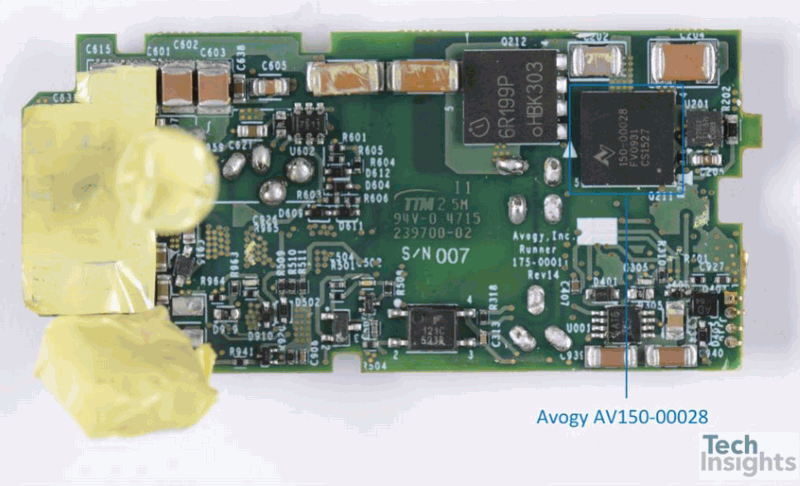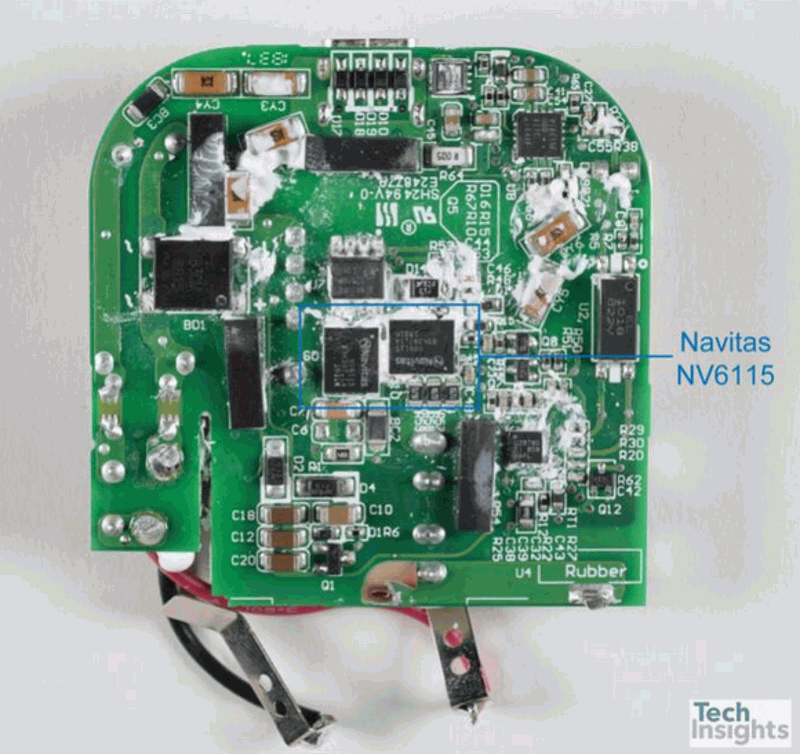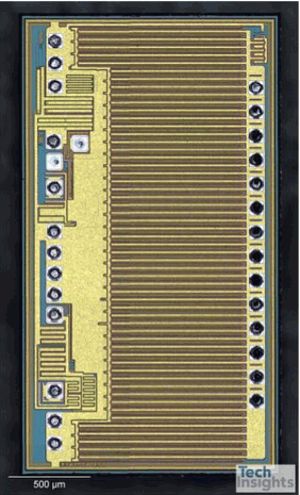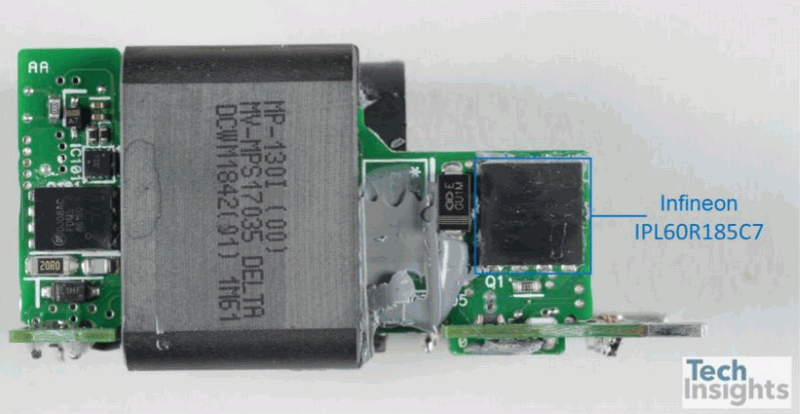Blog: GaN, SiC or Si?
Article By : Sinjin Dixon-Warren

Effective high-power, compact AC adapters can be built using SiC, GaN, and Si super junction devices, according to an analysis by TechInsights of three key products.
AC adapters are a constant reminder that the mobile devices we have come to love are not quite as mobile as we would like to think. Every mobile device needs to regularly revisit an AC adapter to recharge its lithium ion battery.
While the requirement remains the same, the technology behind recharging is changing. Silicon is a mature technology in this field, but manufacturers now are considering silicon carbide (SiC) and gallium nitride (GaN) options to achieve greater efficiencies.
Originally, most AC adapters were essentially a linear power supply that combined a transformer with a bridge rectifier and a capacitor filter to convert the AC main voltage to a smooth low voltage DC current suitable for charging a battery. These adapters were limited to specific AC voltage input to create specific DC voltage outputs and could generally not be used internationally. They were also heavy, cumbersome and a different adapter was usually required for each device needing DC power. In addition, the linear transformer-based technology was inefficient since unneeded power was dissipated as heat and they dissipated power even when there was no load current.
Switch mode power supplies (SMPS) have been gradually displacing linear transformer-based technology since the 1980’s. A variety of circuit topologies are used, but essentially, they are all based on the same principle. The AC voltage is rectified to a high DC voltage that drives a switching circuit, which contains a transformer operating at a high frequency and outputs DC current at the desired low voltage.
The great benefit of SMPS is that they can be used with various AC input voltages and frequencies and thus “international” adapters can be produced. Furthermore, they can be configured to produce a variety of DC outputs. Voltage regulation is achieved by varying the ratio of on-to-off time of the high voltage switching circuit.
The relatively new USB-C power delivery standard aims to provide variable charging power up to 100 W (e.g. 20 V and 5 A), so that a single AC adapter can then be used to charge a wide variety of devices. Furthermore, the cables are bi-directional meaning the same cable can be used to charge a laptop from a monitor or a smartphone from the laptop. The charging power and voltage is dynamically configured when the devices are connected.
SMPS for consumer applications typically require a field effect transistor (FET) rated for about 600 V. This FET is used for the high frequency switching of the high voltage that drives the transformer in the SMPS.
Suitable FET’s can be fabricated with wide bandgap gallium nitride (GaN), silicon carbide (SiC), or with silicon (Si). Silicon super-junction MOSFET technology presently dominates the mobile device AC adapter market, but GaN and SiC devices promise higher efficiency and smaller form factors.
The GaN devices being proposed are lateral high electron mobility transistors (HEMT) formed on GaN-on-Si substrates. There are several AC adapter startups playing in the wide bandgap market space, but so far none of the major OEMs have adopted this technology. Next, I'll take a look at three key devices and compare them.
The Avogy Zolt – SiC, not GaN
In 2016 TechInsights looked inside the Avogy Zolt laptop charger model number ZM070LTPX01-G. Avogy claimed to be a vendor of GaN devices, but TechInsights found that the Zolt contained a SiC power FET, likely fabricated by Cree, but packaged with Avogy markings.
Our colleagues at PntPower.com subsequently argued that one of the reasons Avogy used a SiC device was that SiC was available and working at that time. The picture shows the main PCB from the Zolt laptop charger, with the location of the AV150-00028 SiC device indicated.
Avogy no longer exists as an independent company, but the Avogy Zolt is still available for purchase through third-party retailers. TechInsights tracked 14 design wins for the Zolt at companies including Infineon, Maxim, Microchip, and Texas Instruments.

A look at a GaN device, the RAVPower RP-PC104
Since 2016 GaN has made considerable progress in the commercial market. There are an increasing number of vendors that are now offering AC adapters based on GaN, including RAVPower, Anker, FINsix, Made in Mind (Mu One) and others.
Many vendors now offer GaN FET devices, ranging from small startups like GaN Systems and Navitas to large established players like Infineon and Panasonic. Recently, TechInsights published some results for the RAVPower RP-PC104 45 W USB-C charger which was advertised to contain GaN.
We found the RP-PC104 contained two Navitas NV6115 GaN power IC’s. The photograph below shows the RP-PC104 main PCB with the location of the Navitas NV6115 annotated.

TechInsights subsequently found the Navitas devices in the Made in Mind Mu One 45 W charger, and in the Aukey PA-U50 24W USB charger. The Mu One charger had essentially the same design as the RavPower charger. Both appear to be based on Navitas reference designs.
The Aukey PA-U50 was of particular interest, since it was found to contain the new Navitas NV6250 integrated half bridge IC, which TechInsights is currently examining in detail. The photograph below shows the NV6115 integrated GaN HEMT die from the RP-PC10.

Plugging into the Innergie 60 C–Si, not GaN
TechInsights recently purchased an Innergie 60C USB-C 60 W adapter, made by the Delta Electronics Group and expected to contain a GaN device. Internet rumors suggested that the device contained a 600 V Infineon CoolMOS super junction MOSFET and that Delta had obscured the markings with security paint.
TechInsights’ teardown of the Innergie 60C confirmed both the presence of the 600 V Infineon IPL60R185C7 CoolMOS device and the use of security paint. Furthermore, it did not find a GaN component.
A photograph below shows one of several small PCBs found inside the Innergie 60C. The location of the Infineon IPL60R185C7 600 V CoolMOS, with the markings obscured, is annotated. TechInsights plans to complete a detailed analysis of the 600 V Infineon IPL60R185C7 CoolMOS device.

Conclusions on the outlook of AC adapters
Curiously, in the case of the three AC adapters discussed, the Innergie 60C appears to provide the best overall system performance (see table below).
One of the metrics for performance of a mobile charger is power density, namely the watts produced per cubic inch of volume. The Innergie 60C is a clear winner by this metric, with the highest power density, at 17.4 W/in3. The older Avogy Zolt is the has the largest volume and the lowest power density.
Delta, maker of the Innergie 60C, is an established manufacturer of AC adapters and claims to manufacture 80 million notebook adapters per year. It is likely that the design of the Innergie 60C is highly optimized. Further optimization is required for GaN-based devices, if they are to effectively compete with silicon super junction MOSFET technology.
Inspection of several commercial chargers from major OEMs, including the Google Pixel 3, Huawei Mate 200 Pro and the Nokia 9 PureView fast charger found silicon super junction MOSFET technology. Quite clearly, silicon technology continues to dominate this market space.
Due to the relatively high cost of SiC technology, it is unlikely to achieve widespread success in the AC adapter market. Instead, this technology is better suited to high-voltage applications, and it is successfully displacing silicon IGBT technology in the electric and hybrid vehicle market.
TechInsights found GaN AC adapters do not yet out-perform high quality super junction-based AC adapters in terms of power density. Nevertheless. the known technological benefits of GaN combined with widespread industry interest in developing GaN-based solutions will result in market success for GaN in the AC adapter market. We expect to find GaN more often in high efficiency, small form factor, higher power AC adapters.
There are, at present many players in the GaN HEMT power transistor market, including both relatively new start-ups and large established players. At this time, it seems there are separate market niches for Si and SiC technologies, and we expect to see incremental innovations moving forward that make GaN a bigger player in the adapter space.

– Sinjin Dixon-Warren is a process analyst engineer at TechInsights.